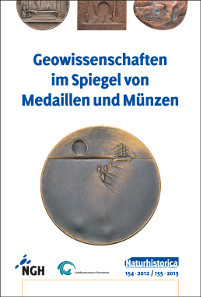by Ursula Kampmann
translated by Annika Backe
September 3, 2015 – Whosoever holds the weighty catalog “Geowissenschaften im Spiegel von Medaillen und Münzen” (translates as “Geo sciences as reflected in medals and coins”) in his hands, is stunned. This is the work of an enthusiast, of whom there are a lot among collectors. Gerd-Henrich Stork combined his passion for numismatics with his professional occupation. From 1969 to 2002, he was a staff member of the Department of Engineering Geology at the Federal Institute for Geosciences. During leisure time he collected all kinds of numismatic objects related to that topic, not only real collectors’ items but also, on a more ‘virtual’ level, to incorporate these into his catalog.
Gerd-Henrich Stork: Geowissenschaften im Spiegel von Medaillen und Münzen, Hannover 2014 (= Naturhistorica 154/155). 724 p., more than 2,300 illustrations. Hardcover, adhesive binding. 18.6 × 26 cm. ISBN 978-3-929444-39-1. 89 euros.
The collection proper comprises 1,400 items. The catalog includes more than 4,000 objects. While the collection was given to the Niedersächsisches Landesmuseum as a present in 2014, these 4,000 objects are incorporated in a catalog that was published by the Naturhistorische Gesellschaft Hannover as volume 154 and 155 of their journal Naturhistorica. The tome is more than impressive! It spans more than 700 pages. It is densely written. It is arranged according to 11 subject matters.
The subject matters are as follows: people, geoscientific institutions, natural monuments, minerals and mineralogical depictions, fossils, earthquakes, diluges and floods, tunnels and drifts, dams, barrages and water power plants, repositories for radioactive waste, and other depictions of geoscientific subjects. The keywords are arranged alphabetically within the relevant chapters. Each keyword has its own number. The medals listed under a particular keyword – of which the interesting ones comprise an awful lot (the author itemizes 73 individual issues for Alexander von Humboldt alone, to which the different material variants add, making a total of 102 coins and medals – if the reviewer’s counting was correct) – are divided by numbers, with a further subdivision by lowercase letters according to material variants.
If we wanted to find something to criticize at all, we could mention the differences in the descriptions’ quality and the lack of a uniform structure. The user should be aware of the fact that the material assembled here is so rich that it would have taken not only one but three books if the author would have attempted to describe and illustrate each and every medal, conforming to the usual numismatic standards. However, the descriptions are perfectly fine to work with, allowing the reader to identify each medal by the description alone, since a number of pieces are not illustrated in the catalog. It is likewise accessible for the user who has no command of the German language. The exact account of the inscriptions renders the identification possible.
The comprehensive keyword index at the end of the book cannot be praised highly enough. It makes the catalog become accessible in an exemplary manner.
This takes us to the final asset. The author has provided almost every object with a comment which boils the object’s significance for the history of geosciences down.
As was said before, the reader is stunned in the face of all the material gathered in this catalog. We can only recommend it, not only to specialized collectors but first and foremost to those who write catalogs themselves. This book is a highly useful new standard work of reference.
The book may be ordered at:
Naturhistorische Gesellschaft Hannover
Geschäftsstelle
c/o Niedersächsisches Landesmuseum Hannover
Willy-Brandt-Allee 5
30169 Hannover
Or email.




